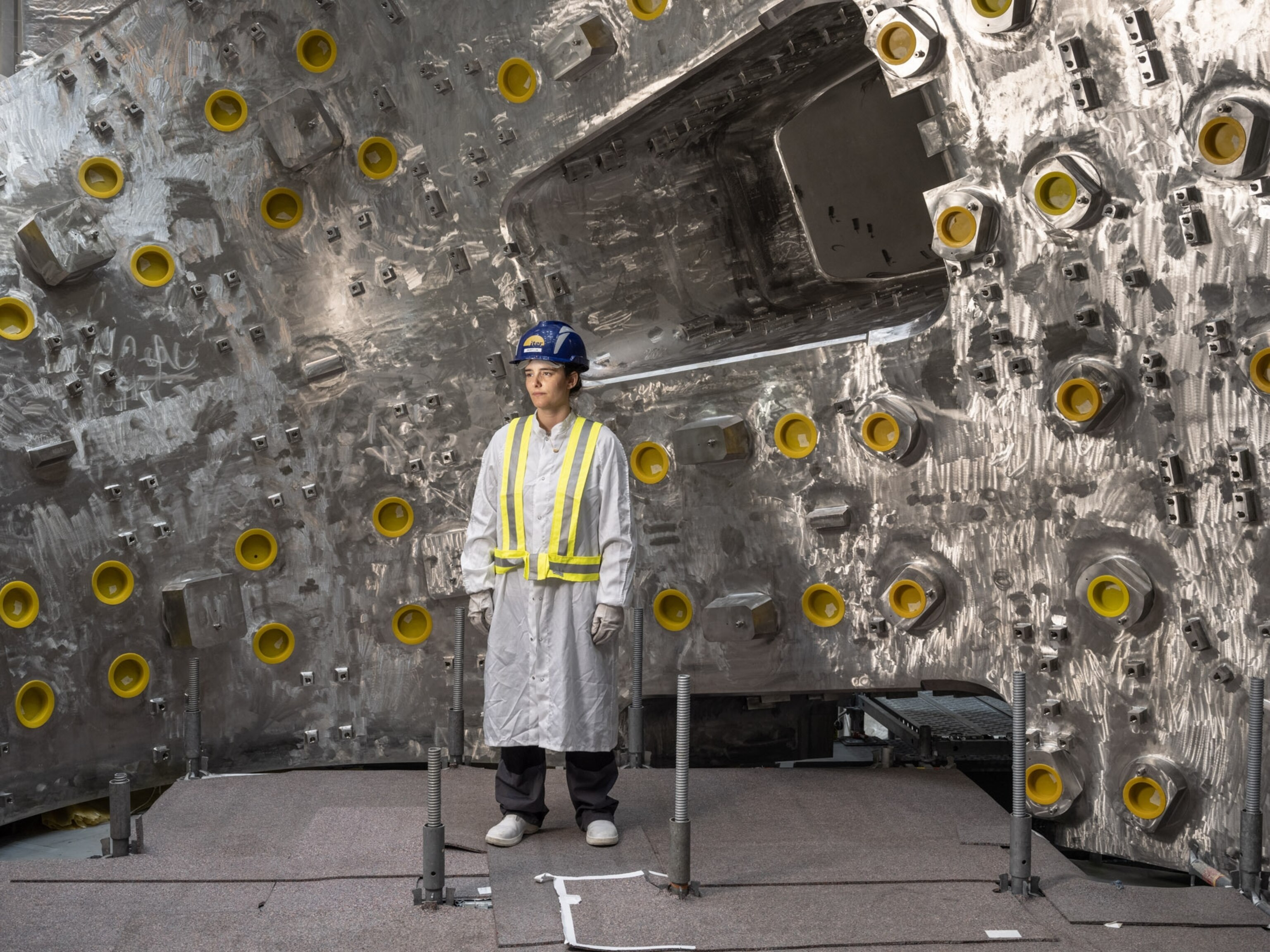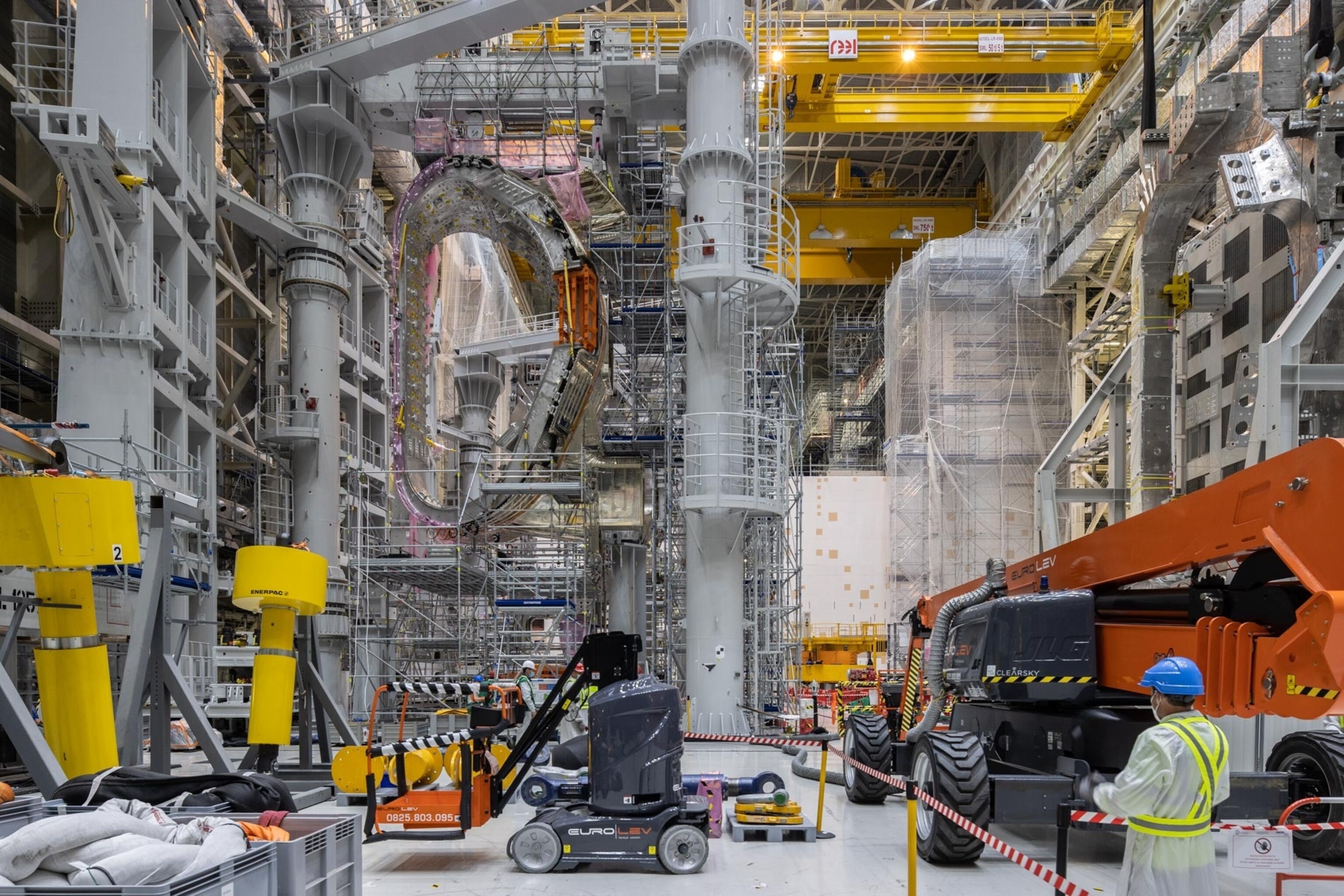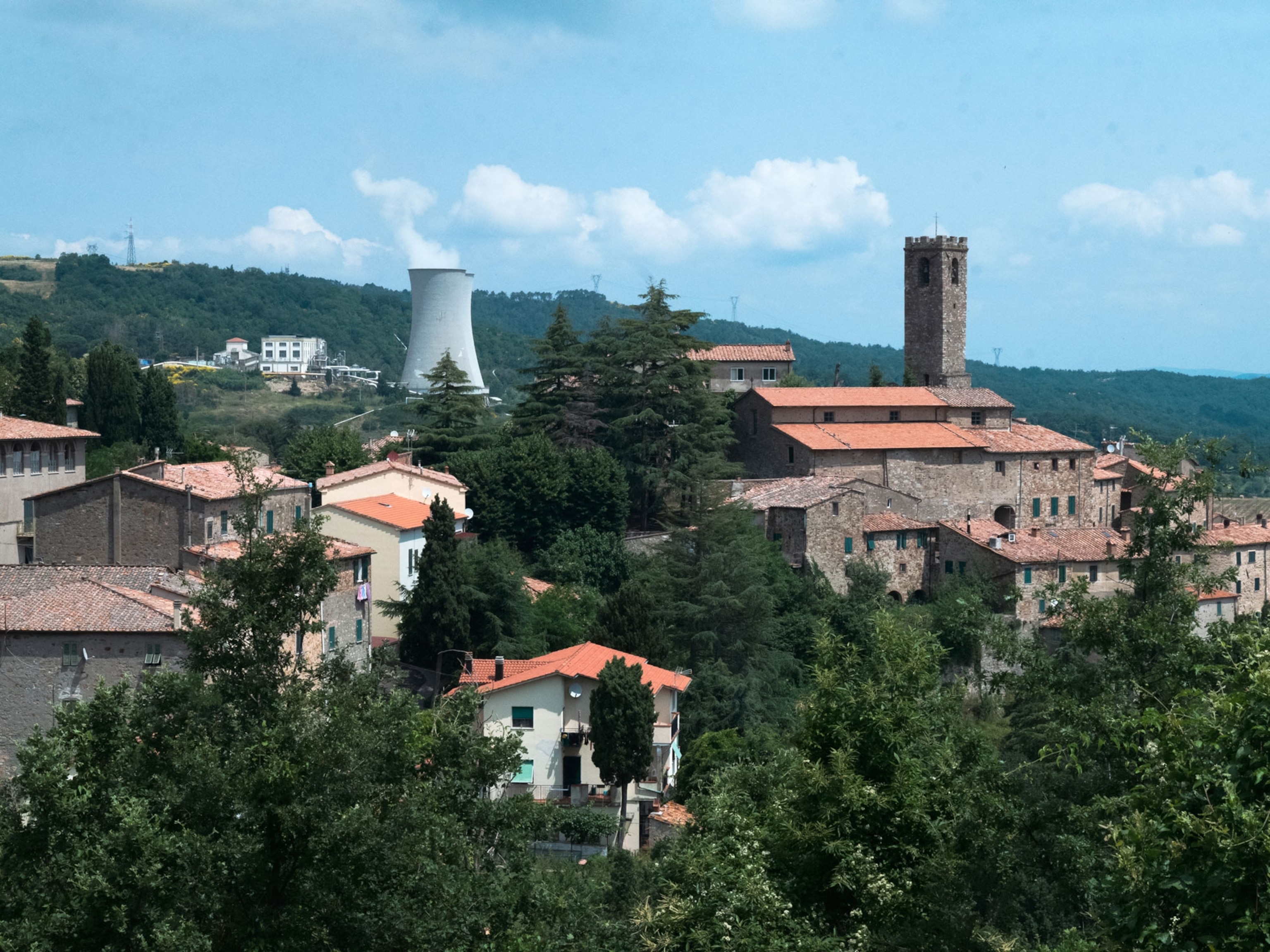
Nuclear fusion powers stars. Could it one day electrify Earth?
The elusive power source can’t save us from the need to cut emissions now. But a $20-billion reactor approaching completion in southern France could pave the way for the future.
For seven years, Bernard Bigot oversaw the construction of a building so ambitious and challenging, and of such significance to humanity, he sometimes thought of it as a cathedral.
Rising from a 445-acre plot in southern France, an hour north of Marseille, it’s a very strange edifice indeed. Not many buildings house cavernous vacuum chambers or require sub-millimeter precision during construction. Fewer still would include a 59-foot-tall magnet powerful enough to lift an aircraft carrier, or enough superconducting niobium-tin wire to circle the equator twice.
The project that Bigot oversaw, called ITER, for the International Thermonuclear Experimental Reactor, is arguably the biggest, most complex, and, at a cost of more than $20 billion, most expensive science experiment ever devised. The consortium of 35 countries financing ITER and building its components represent more than half of the world’s population and 85 percent of global GDP. The U.S., Russia, China, and the European Union are all members.
Some of ITER’s incoming components are so massive, France has had to widen or reinforce 64 miles’ worth of roads and bridges to get them to the construction site in Saint-Paul-lez-Durance. When the reactor is completed, no sooner than 2025—it’s about three quarters of the way there now—it will have taken 40 years of negotiations, design work, and construction to get there.
All of this in service of an audacious goal and a half-century old dream: To generate energy by harnessing nuclear fusion, the power source of the stars. Fusion, if it can ever be tamed, promises abundant power without smokestack fumes or planet-baking carbon emissions, without reactor meltdowns or long-lived radioactive waste—power on demand 24/7, with seawater as the ultimate source of fuel.
But realizing this dream is an engineering nightmare.
On Earth, coaxing hydrogen nuclei to fuse into helium requires creating and confining a “plasma”—an electrically charged gas, where electrons are no longer bound to atomic nuclei—at temperatures several times hotter than inside the sun. Scientists learned long ago how to unleash the process explosively inside hydrogen bombs, and today’s fusion reactors can make it happen in a controlled way for fleeting instants. But no reactor has ever put net power into the electrical grid.
Nor will ITER: Immense as it is, it’s only an experiment designed to get scientists a giant step closer to that grail. ITER’s goal is merely to surpass “scientific breakeven”— the threshold at which a reactor releases as much energy through fusion as it uses to heat the plasma.

On the most optimistic timeline, a prototype fusion power plant won’t be ready until the early 2030s. That means fusion can’t save us from the need to act now to reduce carbon emissions. According to the Intergovernmental Panel on Climate Change, the world needs to cut annual CO2 emissions by roughly half in the next two decades to avoid dangerous warming of more than two degrees Celsius. With cheap solar and wind power readily available, the world can already slash emissions by expanding the use of existing technologies.
“We need electricity generation to be largely decarbonized by 2035,” Nick Eyre, a professor of energy and climate policy at Oxford University, says in an email. “Fusion can deliver nothing on these timescales.”
Harnessing nuclear fusion is among the hardest things humankind has ever attempted, and the technology’s elusiveness has long made it the butt of a joke: for more than half a century, fusion energy has always been “30 years away.” But that bitter joke might finally be wearing thin.
ITER is not the only reason: In labs around the world, researchers have been chipping away at the many technical challenges on the way to a viable fusion reactor. Meanwhile, according to the Fusion Industry Association, investors have poured more than $1.8 billion into private fusion companies that are angling to make the elusive energy source work.
The “joke had its truth,” says Josefine Proll, a fusion theorist at the Eindhoven University of Technology in the Netherlands, but “not anymore. I think we’re on a good track.”
It’s still a long one, with no guarantees the goal of reliable fusion power will ever be reached—but fusion researchers are accustomed to that. Bigot, who became ITER’s director-general in 2015 and died in May at the age of 72, always had his eyes on the horizon. A chemist by training, he saw ITER as medieval architects saw their cathedrals: a project for eternity, where those who lay the foundation may not live to see the spires.
“I guess—with all honesty and humility—we have embarked on such a challenge,” he said in a March interview with National Geographic. “The benefit for humanity could be so large, it is really worth it to try.”
Fusion v. fission
A fusion plant would be fundamentally different from today’s nuclear power plants. They rely on nuclear fission, which releases energy when large, heavy atoms—such as uranium—break apart due to radioactive decay.
In a fusion reactor, in contrast, small, light atoms, such as hydrogen, fuse into bigger ones, releasing a small part of their mass as energy in accordance with Einstein’s iconic equation E = mc2. It revealed that an enormous amount of energy is bound up in even tiny amounts of matter.

In ITER’s case, the reactor will start with a fuel of deuterium and tritium, two heavier forms of hydrogen. At high temperatures, pairs of these atoms’ nuclei will smash into each other with enough oomph to fuse. Each fusion event will create a helium-4 nucleus as well as a high-energy neutron. Many of these neutrons will then bombard the reactor’s walls, generating heat that could one day be used to boil water, make steam, and turn turbines to generate electrical power.
To keep this hot plasma from cooling off, it will be suspended in the center of a doughnut-shaped vacuum chamber by a series of powerful electromagnets. The required electricity to suspend the plasma means each of ITER’s coils must be cooled with liquid helium—which is a bone-shattering minus 452.5 degrees Fahrenheit (4 kelvins).
Ten times hotter than the sun
Atomic nuclei are positively charged, so they fiercely repel one another. In the cores of stars, immense pressure squeezes them close enough to fuse, but such pressures aren’t achievable on Earth. Scientists here must make up for the lower pressure with extreme heat: ITER’s plasma will need to reach temperatures of 270 million degrees Fahrenheit, a full ten times hotter than our sun’s core.
Achieving these conditions—let alone maintaining them—has been a decades-long quest. For years fusion experiments set one-off records for plasma temperatures, plasma densities, or confinement durations, but not all at once.
“In the past, we have had beautiful results … [but] the results that we had in individual labs were, in a sense, separate,” says Ambrogio Fasoli, the chair of Europe’s EUROFusion collaboration and the director of the Swiss Plasma Center in Lausanne.
To this day, no tokamak—ITER’s style of doughnut-shaped reactor—has ever reached all the right conditions to achieve scientific breakeven, where energy out equals the energy needed to heat the plasma, and the ratio of the two, known as Q, equals 1. The best ever done with a tokamak was a Q value of 0.67, briefly, back in 1997.
And scientific breakeven is just one step. "Wall-plug breakeven," at which the reactor releases more power through fusion than it draws out of the grid—the ultimate goal—is far more challenging, in part because fusion reactors require vast amounts of power to keep themselves running, even beyond the energy needed to heat up the plasma. Nevertheless, scientific breakeven has cemented itself as a potent symbol of fusion progress—or, as Fasoli puts it, “a psychological step” to overcome.
Half a century in the making
ITER is designed to blow past scientific breakeven and reach Q values of at least 10. At those energies, the plasma will start to “burn,” or produce much of the heat needed to keep fusion going.


This bonfire has taken longer than expected to ignite. Since the 1950s, researchers have built a series of bigger and more powerful experimental fusion reactors, many based on the tokamak, which was originally developed by the Soviet Union. A 1985 summit between Ronald Reagan and Mikhail Gorbachev opened the diplomatic door, and the U.S. and U.S.S.R. agreed to collaborate on building a tokamak large enough to achieve scientific breakeven. By the end of the 1980s, Japan and Euratom, Europe’s nuclear research organization, had signed on as well, and scientists and engineers started drafting designs for ITER—an acronym, but also Latin for “the way.”
Like many large engineering projects, ITER has dealt with years of delays, ballooning costs, and sometimes poor management, according to a damning 2013 assessment. Since Bigot’s arrival in 2015, though, ITER has gotten on track. It’s now more than three-quarters complete. In April, South Korea delivered a 485-ton sector of ITER’s vacuum vessel; the installation of its 59-foot-tall central solenoid electromagnet, from the U.S., will start no sooner than the end of next year.
Critical tests at smaller reactors have validated ITER’s key design choices. In 2021, the Joint European Torus (JET) in Culham, England, set a single-run record for the total energy released by a fusion reactor’s plasma: 59 megajoules in a five-second test. That’s less energy than the average U.S. residential electricity customer goes through in a day—but JET worked using the same deuterium-tritium fuel that will power ITER and the same materials for the reactor vessel’s inner lining. ITER is expected to generate thousands of times more energy per run than JET.
“ITER, at the beginning … was something that was not, you know, something to be totally proud of, because it was starting very, very slowly … [and] the construction side was idle for quite some time at the beginning,” Fasoli says. “Now it's almost complete, and you can visualize it. It is one of the most amazing things mankind is doing—one of the most ambitious projects we have ever undertaken.”

Different flavors of fusion
If ITER works without a hitch, humankind will still require a next generation of demonstration reactors to reach the promised land of a viable power plant, which Fasoli estimates would need to hit Q values of at least 30. But ITER isn’t the only game in town: Publicly funded research labs and private companies around the world are trying out different techniques, sometimes at much faster speeds than ITER. “With these startups, I think so much more is possible,” says Proll, the Eindhoven theorist.
Commonwealth Fusion Systems, a Cambridge, Massachusetts, spinoff of MIT, is designing a tokamak with magnets made of newer materials than ITER’s. These more powerful magnets should be able to achieve ITER-like Q values with a smaller reactor. Last year, the company announced that it had successfully tested its magnet design, and an experimental reactor nicknamed SPARC is scheduled to come online in 2025.
Other teams are refining entirely different reactor designs. At the National Ignition Facility (NIF) in Livermore, California, arrays of powerful laser beams converging on a tiny pellet heat and compress the hydrogen inside to such a degree that fusion occurs. In 2014, NIF researchers claimed they had reached a version of breakeven with this technique, called inertial confinement, but others have noted that the 2014 study’s definition of “breakeven” was too narrow. In any case, to be a viable power source, NIF’s style of reactor would have to exceed Q values of at least 100—and it’s not close yet.
Some companies are exploring different fuels as well as different designs. California-based TAE Technologies, which has been in business since 1998, is building a nuclear reactor that’s designed to fuse hydrogen with boron-11 by colliding plasma “smoke rings” inside a long, cigar-shaped chamber. This setup would need to hit temperatures even higher than those in tokamaks. But if scaled-up versions work, they could generate electricity without the neutron fusillade that will slam into ITER’s walls.
Tapping the energy in those neutrons to make electricity, as ITER and most kinds of fusion reactors aim to do, is a challenge. Even the most heat-resistant materials used to line reactor vessels, such as titanium and beryllium, will become radioactive and get steadily weaker and more brittle under the neutrons’ incessant walloping. At JET the reactor is maintained with a pair of remotely operated robots that, among other things, replace the reactor’s inner tiles.
Decades still to go
If fusion does become an economically viable power source, we’ll need a plan for how to use it.
In practically any swift emissions-cutting scenario, wind and solar power would need to generate most of the U.S.’s energy by 2050. But some parts of the economy will be difficult to decarbonize, such as the steel industry, which requires large amounts of steady heat. If fusion worked, it could help provide large amounts of reliable power for heavy industry and also help smooth out any variability in wind and solar power, says Sally Benson, the White House’s chief strategist for the energy transition.
Benson adds that to meet the U.S.’s climate goals, many processes that now run on fossil fuels must be electrified—which is projected to cause the nation’s power demand to double from 2035 to 2050. Fusion may not be ready in time to meet this surge in demand, but it could help in the latter half of the century.
“Renewables are great. They're cheap, they're everywhere, [and] you can get them everywhere. But most studies now suggest that providing the kind of 24/7 reliability that you’re going to need will require some kind of dispatchable resource,” Benson says, referring to power generation that can be turned on and off at will, unlike solar and wind. Coal, gas, and nuclear provide this baseload energy now. Hydropower and geothermal could in the future, but they’re not available in every region—a limitation that fusion theoretically would not have.
“I think it really makes a case for trying to diversify the set of options to include a technology such as fusion,” Benson adds. “If it worked, it'd be fabulous.” At an April summit, the White House announced that it was launching a Department of Energy fusion initiative and rolling out $50 million in funding opportunities for future fusion research.
Is it folly to roll the dice on fusion, with an uncertain return? Like ITER’s Bigot, Benson has her eyes on the horizon.
“We’re in this for the long run, right? You know, it's not like we get to 2030 or ‘35, or even 2050 and we’re done.” The goal, she says, is to have a “whole new set of options that will really set us up for the [rest of the] 21st century.”
Related Topics
You May Also Like
Go Further
Animals
- This ‘saber-toothed’ salmon wasn’t quite what we thoughtThis ‘saber-toothed’ salmon wasn’t quite what we thought
- Why this rhino-zebra friendship makes perfect senseWhy this rhino-zebra friendship makes perfect sense
- When did bioluminescence evolve? It’s older than we thought.When did bioluminescence evolve? It’s older than we thought.
- Soy, skim … spider. Are any of these technically milk?Soy, skim … spider. Are any of these technically milk?
- This pristine piece of the Amazon shows nature’s resilienceThis pristine piece of the Amazon shows nature’s resilience
Environment
- This pristine piece of the Amazon shows nature’s resilienceThis pristine piece of the Amazon shows nature’s resilience
- Listen to 30 years of climate change transformed into haunting musicListen to 30 years of climate change transformed into haunting music
- This ancient society tried to stop El Niño—with child sacrificeThis ancient society tried to stop El Niño—with child sacrifice
- U.S. plans to clean its drinking water. What does that mean?U.S. plans to clean its drinking water. What does that mean?
History & Culture
- Séances at the White House? Why these first ladies turned to the occultSéances at the White House? Why these first ladies turned to the occult
- Gambling is everywhere now. When is that a problem?Gambling is everywhere now. When is that a problem?
- Beauty is pain—at least it was in 17th-century SpainBeauty is pain—at least it was in 17th-century Spain
- The real spies who inspired ‘The Ministry of Ungentlemanly Warfare’The real spies who inspired ‘The Ministry of Ungentlemanly Warfare’
- Heard of Zoroastrianism? The religion still has fervent followersHeard of Zoroastrianism? The religion still has fervent followers
Science
- Here's how astronomers found one of the rarest phenomenons in spaceHere's how astronomers found one of the rarest phenomenons in space
- Not an extrovert or introvert? There’s a word for that.Not an extrovert or introvert? There’s a word for that.
- NASA has a plan to clean up space junk—but is going green enough?NASA has a plan to clean up space junk—but is going green enough?
- Soy, skim … spider. Are any of these technically milk?Soy, skim … spider. Are any of these technically milk?
- Can aspirin help protect against colorectal cancers?Can aspirin help protect against colorectal cancers?
Travel
- What it's like to hike the Camino del Mayab in MexicoWhat it's like to hike the Camino del Mayab in Mexico
- Is this small English town Yorkshire's culinary capital?Is this small English town Yorkshire's culinary capital?
- Follow in the footsteps of Robin Hood in Sherwood ForestFollow in the footsteps of Robin Hood in Sherwood Forest
- This chef is taking Indian cuisine in a bold new directionThis chef is taking Indian cuisine in a bold new direction







